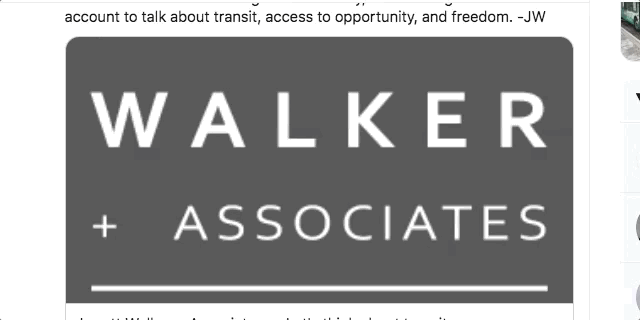
Here’s what happens when Jarrett Walker takes over your Twitter account

A week ago, we gave the experts at Jarrett Walker + Associates the keys to our Twitter account to explain what a transportation system oriented around improving people’s access to jobs and services (not increasing vehicle speed) actually looks like.
Last week was “Connecting people to jobs and services week” on our blog, where we focused on explaining our third principle for transportation investment. As we learned when brainstorming ideas for the blog for this week, the concept of measuring transportation success by access, not vehicle speed is often a tricky one for people to wrap their heads around.
So who better to explain how far we’ve deviated from transportation’s purpose—to connect people to opportunity—and how to get back on track than transit planner Jarrett Walker? Walker and his team are famous for communicating the “geometric truth” (as our outreach director Chris Rall calls it) of transit projects, helping cities across the world align their land use with transit goals.
Check out the highlights of the takeover below. And tune into our Twitter account for more takeovers and tweet chats!
Transportation is a derived demand with no value in itself – we don't commute for the fun of it. The value of transportation comes from its ability to expand people's freedom.. to connect people with opportunity. The more efficiently we can do that, the better -JWA @humantransit
— Transportation for America (@T4America) November 19, 2019
This map shows where you can get in 45 mins on transit from somewhere in Miami. If you're a busy person on transit, the edge of the blue blob is basically the wall around your life. Beyond it are places you can't visit, jobs you can't hold. How can we make you more free? -JWA pic.twitter.com/OXW00w31pg
— Transportation for America (@T4America) November 19, 2019
You can make similar travel-time maps for transit, walking, cycling, even driving, and they all work the same way. Ultimately, you connect people to more opportunity by A) Expanding the area that you can easily reach B) building more opportunities within that area. -JWA pic.twitter.com/7XLyG0K6Xi
— Transportation for America (@T4America) November 19, 2019
Here's the problem: we can never make travel fast enough if we keep putting new jobs/services even farther. Building vast highway (or transit) networks to connect ppl w/ opportunity is useless if they keep locating farther and farther away.-JWA https://t.co/M4MxHVkEtY
— Transportation for America (@T4America) November 19, 2019
If our goal is to connect people to the most opportunity possible, we should do what it takes to encourage more residents and jobs to locate in highly accessible places. For transit that is dense, linear corridors. We call this the Ridership Recipe. -JWA https://t.co/GJFXAWyzT5
— Transportation for America (@T4America) November 19, 2019
The way we invest in urban transportation is needlessly adversarial because it’s a simple problem: cities have little space. Cars are big. Big things don’t fit in little spaces. So in cities, more freedom means investing in walking, biking and transit.-JWA https://t.co/4xjUQ6oatx
— Transportation for America (@T4America) November 19, 2019



